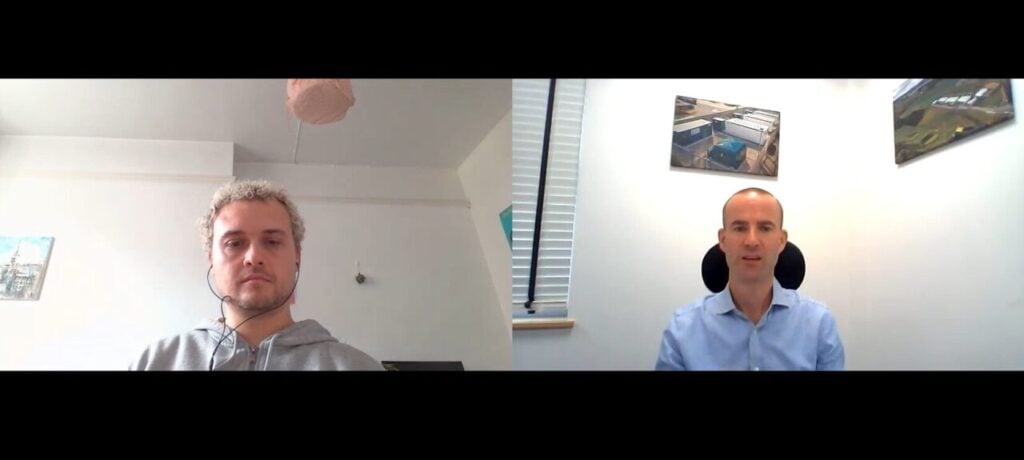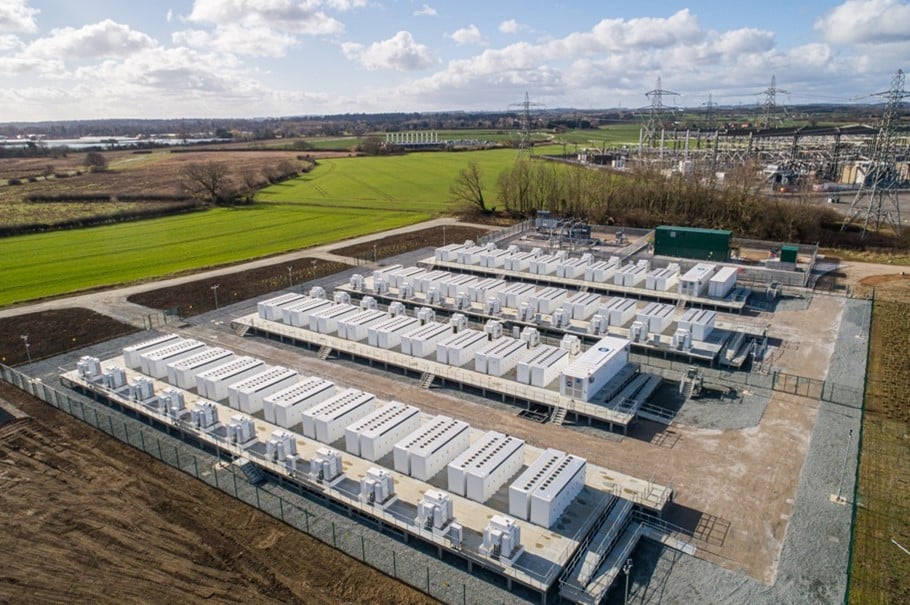
We catch up with the CEO of BESS developer Harmony Energy about its strategy and plans going forward, following the sale of its affiliated Harmony Energy Income Trust (HEIT).
The firm was one of the early movers in the UK battery energy storage system (BESS) market, at one time having the two largest operational projects in Europe, at 100MW/200MWh each.
Those are part of an eight-project portfolio totalling 395.4MW/790.8MWh of capacity which sits within Harmony Energy Income Trust (HEIT), a listed vehicle set up by Harmony Energy as investment advisor, which had first refusal on the projects Harmony Energy developed and sold in the UK.
Following a period of falling UK revenues for BESS, HEIT and other BESS funds saw their valuations plummet and dividends scrapped. HEIT was subsequently sold (and de-listed) to investor Foresight Group, for an enterprise value representing a 94% premium to its share price when it announced it was undergoing a sales process.
Try Premium for just $1
- Full premium access for the first month at only $1
- Converts to an annual rate after 30 days unless cancelled
- Cancel anytime during the trial period
Premium Benefits
- Expert industry analysis and interviews
- Digital access to PV Tech Power journal
- Exclusive event discounts
Or get the full Premium subscription right away
Or continue reading this article for free
Harmony Energy continues to provide asset management services for the portfolio.
Alongside this, Harmony Energy has been expanding abroad, recently energising France’s largest BESS and developing a large pipeline in Poland, Germany and Italy.
CEO Peter Kavanagh talks us through the process and the strategy going forward in this interview.
HEIT sale ‘proved us right’
“The HEIT sale proved what we were saying about the net asset value (the NAV, which the market cap was lower than) and has given us credibility in the market, and solid foundations to grow the business privately,” Kavanagh says.
“The sale proved private investors were willing to be more patient, and pay a higher price for assets.”
“We’re going to raise funds in September for our significant pipeline, with 14GW at different stages of development, and 1GW ready-to-build in the UK and aiming for 3GW built across Europe in the next five years.”
That will be a roughly £300 million (US$403.5 million) fundraise run by JLL which, combined with debt, will go towards building out that pipeline.
Harmony Energy will effectively continue as it has done previously, developing, building and operating BESS projects which will be owned by an institutional investment firm, he explains, but this time it will be private capital.
“We’ll be selling down equity in the Harmony Topco, so the investor coming in will be taking on some development risk, whereas HEIT was just a yield play. But that also meant investors weren’t accessing the full value of the BESS lifecycle. You’ll have more upside potential than a listed vehicle,” Kavanagh says.
Positives around the experience with HEIT include the ability to raise debt and also winning friends with how it ran the fund, Kavanagh says.
“We structured our management fee against the share price rather than the NAV. So we absolutely did the right thing for shareholders, but we hadn’t foreseen such a sharp movement in the share price versus the NAV, which was very painful at times.”
France
Harmony energised a 100MW/200MWh project called Cheviré at the port of Nantes Saint-Nazaire Harbour in France earlier in August. An outside investor provided construction financing and the firm will now do a refinancing for that, and it has two other projects in France going to build ‘shortly’, another 150MW of capacity.
“We wanted to keep that momentum up. We could have waited for an equity check to come in but decided to bring it online early. France is not as well known but it is a very strong market, it’s just not as deep, but if you can get assets online early there are very valuable revenue streams to be captured,” Kavanagh explains.
Ancillary service prices are are very attractive right now, he adds, with a good few years left before the need to revert to day-ahead and arbitrage markets. “We’ve always gone for slightly longer duration, to build something that will stand up in the deeper markets.”
Poland
In Poland, Harmony recently sold a 200MW BESS to EDF but is also taking projects into construction to own and operate.
Echoing Harmony Energy Poland’s executive director Michal Maćkowiak, Kavanagh says that the firm is putting less weight onto the country’s capacity market (CM), said to be the bedrock of the business case for storage in Poland.
“Poland is one of those markets where the developer margins are trading lower than everyone expected. We think you drive value by building, owning and operating. I think people put a lot of weight on the CM, relying on a single revenue stream heavily. We attribute less weight to that, going for a 2-hour system, we believe that is the optimum size given capex and revenue projections,” he says.
“It is a tough market in terms of developing. It took basically 12 months to secure grid connections, and now that market is very locked up in terms of grid. The ones we’ve got are great, and it’s quite hard to develop new sites beyond those.”
Germany and Italy
In Germany, said by many to be the ‘hottest market’ for storage in Europe right now, Harmony is in the process of selling a shovel-ready site.
“Our strategy is to build as much as we can, but also by selling one project in each country, that provides us a very valuable data point going into fundraising process, puts cash back in to the business,” says Kavanagh.
“In Germany alone we have 2.9GW which should become shovel-ready by end of next year, mainly 300MW sites, we’ve taken the approach of going large early-on. The market is seeing really high revenues and very high floor levels from tier 1 offtakers.”
Italy is another market drawing a lot of interest, but the firm is about a year away from having shovel-ready projects meaning it will miss out on this year’s MACSE auction, which is expected to kick off Italy’s grid-scale storage market.
“It’s all about finding the right team and partners on the ground. In France and Germany we were lucky that we knew people already. Italy has been attractive for a while, I don’t feel we’ve missed the opportunity but we’re certainly further behind than where we are in those other markets.”
Going merchant
The topic of tolls and contracted revenues has already come up a few times in the conversation, but what is Kavanagh’s overall approach to this versus going merchant?
“As a group in the UK, we’ve been sort of more excited about trading merchant risk because there’s more upside as we’ve seen. Now you have these floors coming in at higher levels that’s really helps open up the market to that capital not comfortable with that merchant risk. Really interesting when you hear about the really high debt levels, sometimes north of 80%,” Kavanagh says.

“I’ve always been passionate about going merchant as I believe in the upside. But we’ve grown to a size where you should hedge your bets, and I think we’ll split something like 50% merchant and 50% floors and tolling. The tolling side is interesting but that market is only of a certain size.”
“From a strategic point of view we are planning mainly merchant, but we’ll definitely utilise a toll or floor offer if it’s attractive.”
Tesla main partner to date but need to diversify
Harmony has mainly used Tesla for its BESS projects to-date but has started to diversify, enlisting Envision Energy for the final two UK projects that made up the eight-project portfolio when they went online in late 2024.
“A few years back we realised we need to diversify, to get most attractive pricing and to keep everyone hot-to-trot. We ran with Envision for those two HEIT projects and they’ve been a great provider. We tendered out to nine different providers, narrowed the field down, and we will look to tender out into the market going forward. Ideally, you want a number of suppliers.”
“The attraction of tesla is how they deliver across the whole piece. When doing multiple projects it really shows who stands up and delivers, but there are some great Tier 1 providers out there.”
Kavanagh’s Poland colleagues Piotr Czembor and Michal Maćkowiak will both be speaking at our publisher Solar Media’s Energy Storage Summit Central Eastern Europe (CEE) 2025 in a month’s time in Warsaw, Poland, on 23-24 September.
